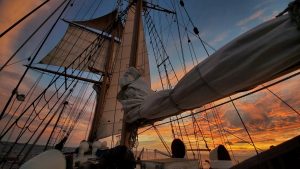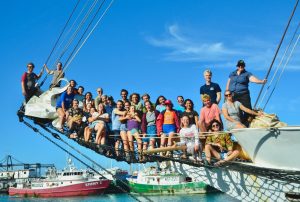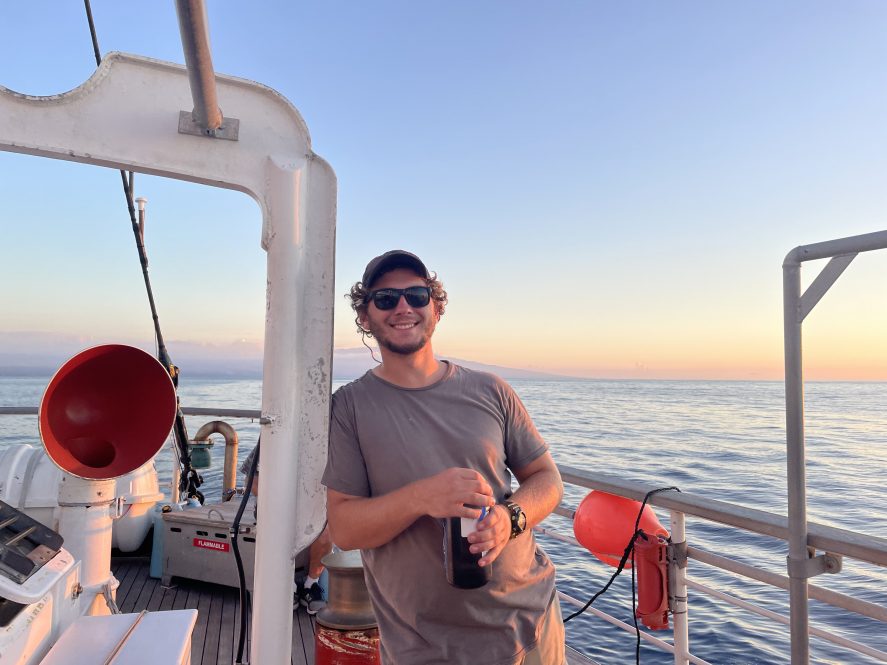Docking on December 23 in Honolulu after 38 days at sea aboard the SSV Robert C. Seamans, Carson Hill ’21 (CLAS) says his participation in the Sea Education Association (SEA) study abroad program was so monumental, it is almost indescribable.
The SEA program consists of 12 weeks: six weeks on land at Woods Hole where students learn and prepare for six weeks at sea. Hill’s SEA experience started in the spring of 2020, but the COVID-19 pandemic put a hold on setting sail. Fortunately, as soon as restrictions lifted, the opportunity to complete the program came up and Hill jumped at the opportunity in the fall of 2021. With the choice to sail either the Pacific or the Atlantic, Hill chose to sail from Catalina Island, California to Honolulu, Hawaii.
Students document their experiences on the SEA Currents Blog. The experience at sea was breathtaking and transformative, says Hill.

“There’s just so much going on, but also so little changing,” he says. “You become very focused and present, especially without internet, it was a nice disconnect from the rest of the world. Aboard the ship, you recognize how important every role is and what that means for what the wind and the waves are doing. Even in your sleep, you become attuned to everything that’s happening on the boat.”
Hill struggles to pick just one favorite experience from the nearly 40 days’ worth of amazing memories, but says that one does stand out:
“I think the most incredible experience from the whole trip was, one night when on dawn watch, we were drifting around the island of Maui, and we heard very clearly what sounded like whales. We ended up having a pod of humpback whales, about seven of them, come right up to the boat, and they circled around us for about an hour and a half. Wow, under the light of the full moon, to experience this beautiful, spectacular display from these massive, incredible, magnificent creatures just doing their thing. You could hear them singing and vocalizing.”
Knowing this was a potentially once-in-a-lifetime experience, they decided to wake the rest of the crew. The memory of 30 people running around on a boat to catch glimpses of whales at three in the morning is a very special image that will endure, Hill says.
Returning to land was a stark transition after six weeks and over 3,968 nautical miles at sea once the crew docked in Honolulu.

“Going into a big bustling city after being completely disconnected for a long time was very jarring,” he says. “It took me several days to get used to it.”
Hill says the trip confirmed for him that working aboard boats is where he sees himself going forward. “Working with the crew, they were role models, and the experience on the boat helped me figure out what kind of person I want to be. SEA is a great educational experience. The whole goal of the trip is to do ship-based oceanographic research. So being able to accomplish that as an undergrad is pretty special.”
From amazing encounters with the natural world, slowing down the frenetic pace of modern life, or building nautical expertise, Hill says the experience also taught vital skills in being a member of a community.
“From the second we step on the boat, we learned that there’s a million things that have to be done in a very specific way,” he says. “And it is not to be strict or controlling, it’s because there’s 30-plus people on this boat, so if we don’t establish good community living standards, and don’t agree on how things are going to go, things can get a bit uncomfortable. Everything you do, from how you should close a cabinet or how to put plates away, seem like small things but they are important. You always feel like you’re doing something wrong, but you pick it up very quickly. Then at the end of it, you realize how far you’ve come. It doesn’t feel like it’s been a struggle of just sitting there studying everything. It’s been living it, it’s been doing the research, it’s been sailing the ship ourselves.”



